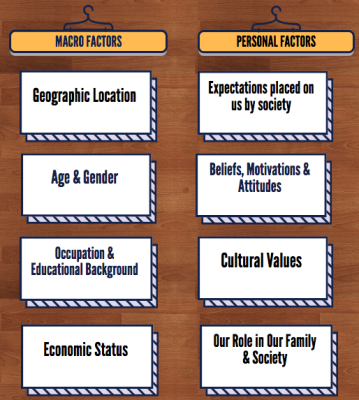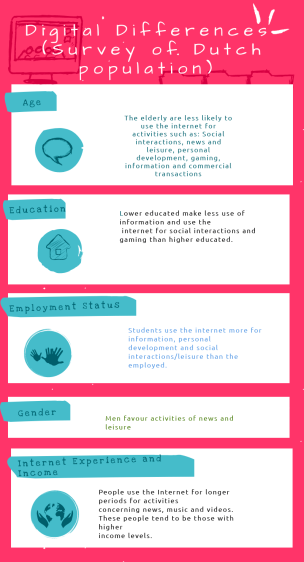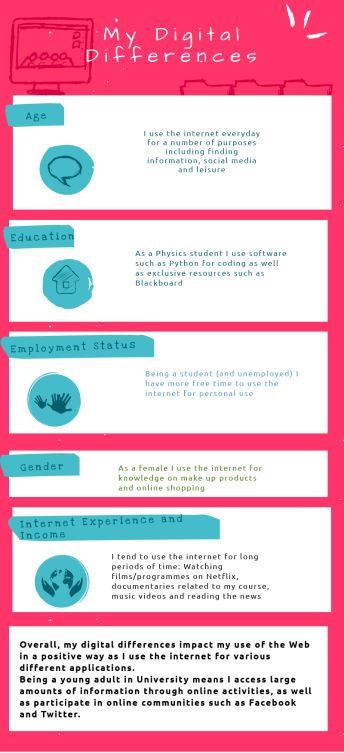
Over the past decade increased Internet adoption and a rise of mobile connectivity has allowed us to bridge the gap in accessing technology and online information for most (Smith and Zickuhr, 2012). However, terms such as ‘digital divide’ and ‘digital differences’ are still frequently used when studying today’s online users. Exploring MOOC and various studies, it is apparent there are common factors that lead to disparities on the Web.
Professor Susan Halford says older people are less likely to use the Web in addition to those in unskilled or semi skilled professions. She explains how those with disabilities may also be confined to using the Web at home, due to limited access of required software. Surveys shown below carried out by Pew Research Center reinforce such observations as statistics (from 2000-2011) show American internet users within age range 18-29, with higher house hold income or educational attainment use the Web more frequently.
Though, it is debatable whether the correlations mentioned can be generalised as a survey of the Dutch population, in 2013, shows in fact that “low levels of education and disabled people are using the Internet for more hours a day in their spare time than higher educated and employed populations” (Van Deursen and Van Dijk, 2013). Therefore, we must look deeper into online behaviours when trying to explain digital differences (rather than time spent).
Interestingly, when analysing online activities, Pew Research shows some gaps are more vast than others; Among all demographics a high level of users ‘search’ the Web though, a significant number of young users are part of online social networking sites in contrast to only a few of the elderly (65+).
In addition, Van Deursen and Van Dijk rank the differences from most prominent to least significant, allowing us to see how the Web is used as a multi purpose tool for different types of users (see chart below). Next to these differences I include my own digital differences to see if I follow any of the general trends.


Word Count: 321
References:
- Future Learn, 2017. Future Learn. Digital differences – inequalities and online practices [Accessed 25 Feb. 2018]
- Halford, S. and Savage, M. (2010) Reconceptualizing Digital Social Inequality, Information, Communication & Society, 13: 7, 937 — 955 [Accessed 25 Feb. 2018]
- Zickuhr, K. and Smith, A. (2012). Digital Differences, Pew Internet, (Pew Research Center) [Accessed 25 Feb. 2018]
- Van Deursen, A. and Van Dijk, J. (2013) The Digital Divide Shifts to Differences in Usages, Sage Journals, 16:3 [Accessed 25 Feb. 2018]
-
Damarin, S. (2000) The ‘Digital Divide’ Versus Digital Differences: Principles for Equitable Use of Technology in Education, Education Technology, 40:4, 17-22 [Accessed 25 Feb. 2018]
Hi Yusra!
I think this is a really informative and engaging post. It was definitely an enjoyable read.
I especially liked your infographics about general digital differences and your personal differences. Also, the distinction between macro and personal factors is really clear and concise. You’ve definitely demonstrated a good understanding of the topic and have shown some good references too.
I suppose the question I would ask then is which factor/s you think impact web use the most? Do you think gender is a more influencing factor or geographical location maybe?
Overall this was a great post! Well done!
~ Karishma
LikeLike
Hi Karishma,
Thank you for your comment!
In answer to your question, the chart I created above is ranked from most impacting factor (being age) to least (being internet experience and income) according to Van Deursen and Van Dijk’s research and I personally agree with the general order and that age is one of the most significant factors to the digital divide.
This is because of the large amount of technology now incorporated into today’s education system i.e in the classrooms.
Just today I was observing a year 7 maths class in a local school where they were using chrome books to do activities on a interactive online teaching website called MyMaths.
Here’s an interesting article I read on the current and future use of technology in education, and also how it impacts their learning skills online and offline : https://www.edweek.org/ew/issues/technology-in-education/index.html
Also while I think gender does influence what you may use the Web for, such as information and choice of leisure, I do think geographical location impacts the use of the Web more on a macroscopic scale as some countries have less access to technology than others.
Thanks for reading
Yusra
LikeLike
Hi Yusra,
Thank you for replying.
That’s a really interesting observation and actually for me, hits home how much technology engulfs our lives, especially those in the younger generation/s.
Thank you for the link – I will definitely have a read of that.
Yes, I also agree with the impact of those other factors. In particular geographical location.
Karishma
LikeLike
Hi Yusra,
I thoroughly enjoyed reading your post! The different references you used have deepened my understanding of the subject.
I was surprised to read that from the Dutch population studied those with lower levels of education and a disability were using the internet for more hours in their spare time than high educated and employed people. This goes against what articles such as these:
https://www.theguardian.com/technology/2015/jun/29/disabled-people-internet-extra-costs-commission-scope
Click to access Evolution%20of%20the%20Digital%20Divide%20Digital%20Enlightment%20Yearbook%202012.pdf
state about education level and disability impacting digital opportunities. I was wondering if you had any personal ideas what the reasons for this statistic being present? (Obviously its important to consider that this statistic is in their spare time and that it is specific to one population)
You suggested we must look further into online behaviours rather than time spent- would you be able to expand on that and suggest what types of online behaviours you might be interested in looking at?
Thanks!
Phoebe
(147 words without links)
LikeLike
Hi Phoebe,
Thanks for reading my blog!
I found the results from the Dutch population survey very interesting too. Maybe due to geographical location there is mixed opinion on certain factors such as disability and education levels.
Looking at the first article you included, rather than going against the Dutch survey results, I think the main concern here with disability is the actual Web accessibility and guidance on how to use softwares rather than looking at time spent. However, there are certain actions taking place to help those with additional needs that I read in the Government Digital Inclusion Strategy policy paper : https://www.gov.uk/government/publications/government-digital-inclusion-strategy/government-digital-inclusion-strategy
So hopefully in the future maybe these issues will improve!
Also the second article is published by the same authors of the Dutch population survey, so I do not think it goes against the findings but rather has an explanation behind the ‘digital usage gap’ between the high and low levels of education/employed and unemployed users. For example, they explain how lower levels/unemployed users are more likely to use the internet for less serious and more entertainment reasons than the higher levels.
Thanks again!
Yusra
LikeLike